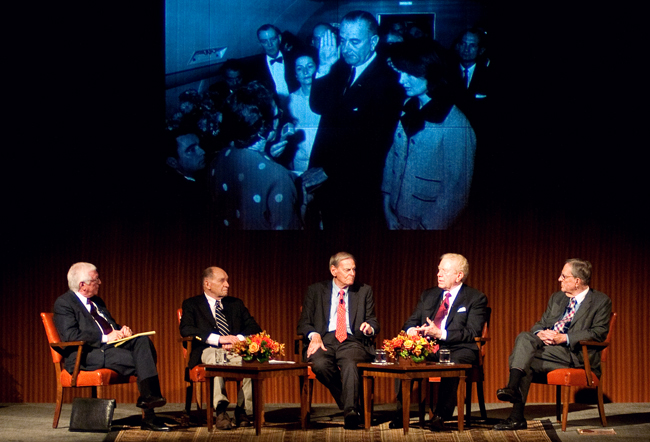Several figures who either witnessed or were involved in planning President John F. Kennedy’s Dallas tour in 1963 dismissed several Kennedy assassination conspiracy theories on campus Tuesday.
The Lyndon B. Johnson Library hosted the discussion in light of the upcoming 50th anniversary of Kennedy’s death, which occurred Nov. 22, 1963.
Larry Temple, then an aide to then-Texas Governor John Connally, said he wanted to debunk several conspiracy theories that have developed over the past 50 years.
According to Temple, Kennedy was not in Dallas to settle divisions within the Democratic party, despite myths which say otherwise.
“The trip was political, there’s no doubt about that,” Temple said. “One, for fundraising, and two, to get around the state so the president could use it as a base for the 1964 election campaign.”
Ben Barnes, a state representative at the time, said pundits mistakenly asserted Kennedy considered taking Johnson off the vice presidential ballot. But without Johnson, Kennedy could not win Texas, a key state to winning the next election.
Barnes also said Lee Harvey Oswald, the man who shot Kennedy and Connally, obtained a job at a book depository several weeks before the parade, and the parade route was changed to pass near Oswald’s workplace. The reason this change was made only days before the event was to give Jackie Kennedy more time to arrive at another reception.
The speakers noted Texans were supportive and excited to see the Kennedys during the 1963 tour.
“The crowd was cheerful,” said Sid Davis, a reporter at the parade. “There was no sign that there was going to be any problems.”
Julian Read, who was the press secretary to Connally, said mobs lined the streets and school children were on their parents’ backs during the Dallas parade.
After Kennedy’s assassination, many Texans felt long-standing bitterness toward Texas, according to Temple.
“There was a feeling of shame from a lot of people that this had happened in their own backyard,” Temple said.
Reed said there was also a lot of bitterness felt by other Americans toward Texans.
“[One] woman had to change [her] address from Dallas to Fort Worth because she lost so much business from people,” Read said.
Davis was one of the three pool reporters on board Air Force One when Johnson was sworn into presidential office following Kennedy’s death.
Davis said when he covered Johnson’s swearing-in, Johnson’s solemnity and First Lady Jackie Kennedy’s courage stood out to him. Davis said Johnson sent word to the back of the airplane to ask Jackie Kennedy if she would like to stand next to Johnson as he was sworn into office. Although John F. Kennedy’s aids were sobbing, Jackie Kennedy — with blood congealed on both legs and brain matter on her skirt and blouse — walked to the front of the plane without crying.
After the ceremony, Davis said Johnson did not want the day to turn into a celebration.
“[Johnson] fended off any effort to congratulate him,” Davis said.
The talk aired live on the Texas Longhorn Network.





















